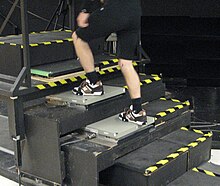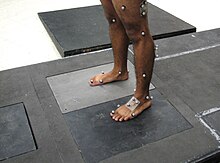
Pressure measurement is the measurement of an applied force by a fluid on a surface. Pressure is typically measured in units of force per unit of surface area. Many techniques have been developed for the measurement of pressure and vacuum. Instruments used to measure and display pressure mechanically are called pressure gauges,vacuum gauges or compound gauges. The widely used Bourdon gauge is a mechanical device, which both measures and indicates and is probably the best known type of gauge.

Biomechanics is the study of the structure, function and motion of the mechanical aspects of biological systems, at any level from whole organisms to organs, cells and cell organelles, using the methods of mechanics. Biomechanics is a branch of biophysics.

Gait analysis is the systematic study of animal locomotion, more specifically the study of human motion, using the eye and the brain of observers, augmented by instrumentation for measuring body movements, body mechanics, and the activity of the muscles. Gait analysis is used to assess and treat individuals with conditions affecting their ability to walk. It is also commonly used in sports biomechanics to help athletes run more efficiently and to identify posture-related or movement-related problems in people with injuries.

A scale or balance is a device used to measure weight or mass. These are also known as mass scales, weight scales, mass balances, and weight balances.
Posturography is the technique used to quantify postural control in upright stance in either static or dynamic conditions. Among them, Computerized dynamic posturography (CDP), also called test of balance (TOB), is a non-invasive specialized clinical assessment technique used to quantify the central nervous system adaptive mechanisms (sensory, motor and central) involved in the control of posture and balance, both in normal (such as in physical education and sports training) and abnormal conditions (particularly in the diagnosis of balance disorders and in physical therapy and postural re-education). Due to the complex interactions among sensory, motor, and central processes involved in posture and balance, CDP requires different protocols in order to differentiate among the many defects and impairments which may affect the patient's posture control system. Thus, CDP challenges it by using several combinations of visual and support surface stimuli and parameters.
A load cell converts a force such as tension, compression, pressure, or torque into a signal that can be measured and standardized. It is a force transducer. As the force applied to the load cell increases, the signal changes proportionally. The most common types of load cells are pneumatic, hydraulic, and strain gauge types for industrial applications. Typical non-electronic bathroom scales are a widespread example of a mechanical displacement indicator where the applied weight (force) is indicated by measuring the deflection of springs supporting the load platform, technically a "load cell".

A rheometer is a laboratory device used to measure the way in which a viscous fluid flows in response to applied forces. It is used for those fluids which cannot be defined by a single value of viscosity and therefore require more parameters to be set and measured than is the case for a viscometer. It measures the rheology of the fluid.

Tonometry is the procedure eye care professionals perform to determine the intraocular pressure (IOP), the fluid pressure inside the eye. It is an important test in the evaluation of patients at risk from glaucoma. Most tonometers are calibrated to measure pressure in millimeters of mercury (mmHg), with the normal eye pressure range between 10 and 21 mmHg (13–28 hPa).

A piezoelectric sensor is a device that uses the piezoelectric effect to measure changes in pressure, acceleration, temperature, strain, or force by converting them to an electrical charge. The prefix piezo- is Greek for 'press' or 'squeeze'.

A vertical jump or vertical leap is the act of jumping upwards into the air. It can be an exercise for building both endurance and strength, and is also a standard test for measuring athletic performance. It may also be referred to as a Sargent jump, named for Dudley Allen Sargent.

Ultrasonic transducers and ultrasonic sensors are devices that generate or sense ultrasound energy. They can be divided into three broad categories: transmitters, receivers and transceivers. Transmitters convert electrical signals into ultrasound, receivers convert ultrasound into electrical signals, and transceivers can both transmit and receive ultrasound.

The Wii Balance Board is an accessory for the Wii and Wii U video game consoles. Unlike the usual balance board for exercise, it does not rock but instead tracks the user's center of balance. Along with Wii Fit, it was introduced on July 11, 2007, at the Electronic Entertainment Expo.
Mechanography is a medical diagnostic measurement method for motion analysis and assessment of muscle function and muscle power by means of physical parameters. The method is based on measuring the variation of the ground reaction forces over the time for motion patterns close to typical every day movements. From these ground reaction forces centre of gravity related physical parameters like relative maximum forces, velocity, power output, kinetic energy, potential energy, height of jump or whole body stiffness are calculated. If the ground reaction forces are measured separately for left and right leg in addition body imbalances during the motions can be analysed. This enables for example to document the results of therapy. The same methodology can also be used for gait analysis or for analysis of stair climbing, grip strength and Posturography. Due to the utilization of every-day movements reproducibility is high over a wide age range

Balance in biomechanics, is an ability to maintain the line of gravity of a body within the base of support with minimal postural sway. Sway is the horizontal movement of the centre of gravity even when a person is standing still. A certain amount of sway is essential and inevitable due to small perturbations within the body or from external triggers. An increase in sway is not necessarily an indicator of dysfunctional balance so much as it is an indicator of decreased sensorimotor control.

Pedobarography is the study of pressure fields acting between the plantar surface of the foot and a supporting surface. Used most often for biomechanical analysis of gait and posture, pedobarography is employed in a wide range of applications including sports biomechanics and gait biometrics. The term 'pedobarography' is derived from the Latin: pedes, referring to the foot, and the Greek: baros meaning 'weight' and also 'pressure'.
Sports biomechanics is the quantitative based study and analysis of athletes and sports activities in general. It can simply be described as the physics of sports. Within this specialized field of biomechanics, the laws of mechanics are applied in order to gain a greater understanding of athletic performance through mathematical modeling, computer simulation and measurement. Biomechanics, as a broader discipline, is the study of the structure and function of biological systems by means of the methods of mechanics.
In biomechanics, center of pressure (CoP) is the term given to the point of application of the ground reaction force vector. The ground reaction force vector represents the sum of all forces acting between a physical object and its supporting surface. Analysis of the center of pressure is common in studies on human postural control and gait. It is thought that changes in motor control may be reflected in changes in the center of pressure. In biomechanical studies, the effect of some experimental condition on movement execution will regularly be quantified by alterations in the center of pressure.
There are at least three different types of brake tester used to calculate the braking efforts and efficiencies of a motor vehicle:
X-ray motion analysis is a technique used to track the movement of objects using X-rays. This is done by placing the subject to be imaged in the center of the X-ray beam and recording the motion using an image intensifier and a high-speed camera, allowing for high quality videos sampled many times per second. Depending on the settings of the X-rays, this technique can visualize specific structures in an object, such as bones or cartilage. X-ray motion analysis can be used to perform gait analysis, analyze joint movement, or record the motion of bones obscured by soft tissue. The ability to measure skeletal motions is a key aspect to one's understanding of vertebrate biomechanics, energetics, and motor control.
















